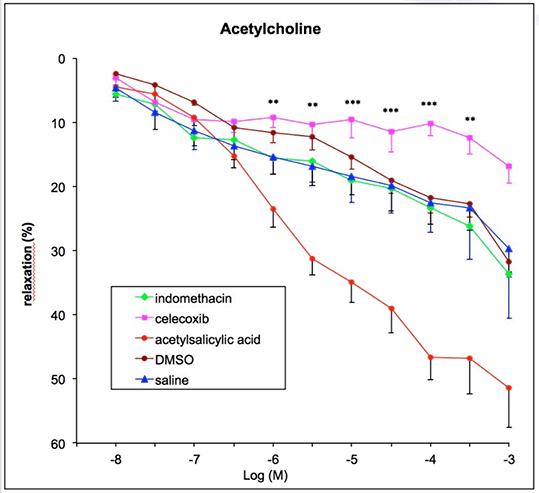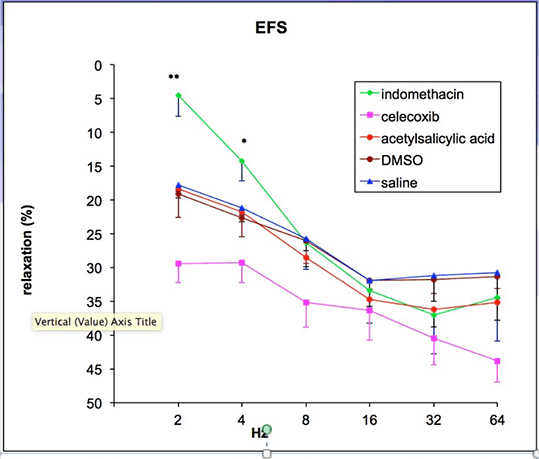| 112P London, UK Pharmacology 2016 |
Effect of nonsteroidal anti-inflammatory drugs (NSAIDs) on rat corpus cavernosum erectile function
Introduction: Although penile erection is a complex process, nitric oxide induced relaxation of cavernous smooth muscle takes a critical part. Nonsteroidal anti-inflammatory drugs (NSAIDs) are one of the most commonly used group of drugs and an association between NSAIDs and erectile dysfunction has been observed. Therefore the main purpose of this study was to evaluate the effect of non-selective COX-inhibitors (acetylsalicylic acid, indomethacin) and a COX-2 inhibitor (celecoxib) treatment on corpus cavernosum functions in rats.
Method: Thirty Wistar albino, male, 310-350 g rats were divided into five groups. Acetylsalicylic acid (30 mg/kg/day), indomethacin (2,5 mg/kg/day), celecoxib (50 mg/kg/day), DMSO, saline were injected intraperitoneally for 30 days. At the end of the treatment period, isolated corpus cavernosum tissues were mounted in 20 ml organ baths containing Krebs solution to record changes in isometric tensions. Cumulative concentration dependent responses of phenylephrine (10-7-10-2 M), acetylcholine (10-8-10-3 M), sodium nitroprusside (10-11-10-3 M), papaverine (10-7-10-3 M) and electrical field stimulation (EFS) (2, 4, 8, 16, 32, 64 Hz) responses were evaluated. EFS responses were repeated after 20 minutes incubation with N-nitro-L-arginine methyl ester (L-NAME) (10-4M). Data are given as mean±SEM (n animals). Kruskal-Wallis analysis of variance and post hoc Dunn’s test were used to analyze the data. This experimental study was approved by Local Ethical Committee on Animal Research of Kirikkale University (14/46-2014, 14/ 78-2014).
Results: Celecoxib reduced both phenylephrine contractions and endothelium-dependent acetylcholine (10-8-10-3 M) relaxation responses while acetylsalicylic acid treatment resulted in increased acetylcholine relaxations (Fig 1). There was no difference in papaverine relaxations among the groups. Indomethacin treatment decreased sodium nitroprusside relaxations in higher concentrations (10-5-10-3 M). Significant differences in EFS induced relaxations were observed in 2 and 4 Hz responses. Celecoxib treatment increased 2 and 4 Hz responses whereas indomethacin decreased them (Fig 2). L-NAME inhibited EFS induced relaxations and contractions were observed in 32 and 64 Hz applications.
Conclusion: Acetylsalicylic acid treatment increased the endothelium dependent relaxations but did not effect the neuronal responses. These data suggest that acetylsalicylic acid increases only endothelial NO but not neuronal NO. Just the opposite celecoxib inhibited endothelial responses but increased neuronal relaxations, suggesting an increase in neuronal NO. On the other hand NSAİDs used in this study did not change the relaxation responses to papaverine which is a phosphodiesterase inhibitor used in the treatment of erectile dysfunction.
References: 1. Gleason JM et al.(2011). J Urol 185(4): 1388-1393 Hafez G et al.(2014) Andrologia 46: 997-1003

Figure 1: Cumulative concentration dependent Acetylcholine (10-8-10-3M) relaxation responses. Each point represents mean ± SEM of 6 experiments. **P<0.01 and ***P<0.001

Figure 2: 2, 8, 16, 32 and 64 Hz Electrical Field Stimulation (EFS) relaxation responses. Each point represents mean ± SEM of 6 experiments. *P<0.05 and **P<0.01

